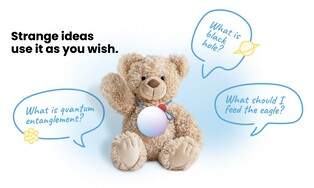 Hardware Tutorial
Hardware Tutorial
 Hardware News
Hardware News
 BubblePal AI companion toy for kids launches with eerily M3GAN-like concept
BubblePal AI companion toy for kids launches with eerily M3GAN-like concept
BubblePal AI companion toy for kids launches with eerily M3GAN-like concept

BubblePal, a newly launched AI-based interactive toy, appears to be something that could have inspired the writers of the 2022 sci-fi/horror flick M3GAN, if it hadn’t just been launched last week. Based on large language model (LLM) technology, the ‘companion toy’ is a voice-controlled, illuminated orb attached to an adjustable lanyard that a child can either hang around their favourite stuffed toy and talk to, or simply interact with it on its own.
The design is suitably simple and innocuous-looking, consisting of food-safe silicone and ABS. A single push-to-talk button on the front comprises the main physical interface, with visual feedback coming from an internal LED that lights up the device in appealing colours. The in-built battery charges via USB-C and offers up to 4 days of standby time.
The initial setup, done through a mobile app, allows parents to choose one of several ‘characters’ that give the toy a unique personality. It also supports multiple languages, though it’s unclear whether it can switch between them for bilingual families. The app also provides insights on the child’s interactions and progress.
AI-driven hardware voice assistants such as the Humane AI Pin and the Rabbit R1 have largely failed to live up to the hype, but Haivivi, the Singapore-based company behind the BubblePal, is confident that its product can “enrich children's development” in several ways.




For one, it can act as a “super encyclopedia”, using the LLM to answer a child’s questions. This seems genuinely useful, serving as an educational aid for young children. Another feature is the ‘interactive storytelling mode’: not only can BubblePal read out stories, but kids can also interact with and participate in the creation of the story, which sounds promising, at least on paper.
Where things get a bit vague is the part about how it uses emotion recognition algorithms and “intuitively senses children's emotions, offering empathetic companionship”. Being AI-based, it can supposedly remember a child’s preferences, some personal details and prior interactions, using them to shape future conversations.
On the rather important privacy front, Haivivi explains that voice inputs get transcribed to text, and then the audio files are promptly deleted. Transcriptions are kept for up to 90 days so parents can review them, after which those get deleted as well.
One eyebrow-raising point is that a pivotal inspiration for this product was a child asking a smart speaker, 'Does my mother love me?'. While Haivivi states that “this revelation underscored the need for technological solutions that cater to children’s needs”, one would think that this isn't something that should be delegated to AI. In fact, it underscores the vital question of what part (if any) of a child’s emotional development can be entrusted to an AI entity.
Digital devices like iPads are already used by many parents as both learning tools and a convenient distraction in some situations. One of the biggest risks with excessive digital exposure is that of stunted social growth: a bright, colourful video or game can keep a children from conversing with others, making friends and learning social dynamics. A voice-controlled, LLM-driven toy certainly provides a more natural form of interaction. However, whether it can genuinely replace the role of a friend or parent, even in part, or merely distorts it, is something we will only discover in practice, as with many aspects of AI.
TheBitzee digital pet toy, available on Amazon, is an interesting alternative to the BubblePal, while theEncyclopedia Britannica Kids edition of the Me Reader electronic story readeris a more educational option.
The above is the detailed content of BubblePal AI companion toy for kids launches with eerily M3GAN-like concept. For more information, please follow other related articles on the PHP Chinese website!

Hot AI Tools

Undresser.AI Undress
AI-powered app for creating realistic nude photos

AI Clothes Remover
Online AI tool for removing clothes from photos.

Undress AI Tool
Undress images for free

Clothoff.io
AI clothes remover

Video Face Swap
Swap faces in any video effortlessly with our completely free AI face swap tool!

Hot Article

Hot Tools

Notepad++7.3.1
Easy-to-use and free code editor

SublimeText3 Chinese version
Chinese version, very easy to use

Zend Studio 13.0.1
Powerful PHP integrated development environment

Dreamweaver CS6
Visual web development tools

SublimeText3 Mac version
God-level code editing software (SublimeText3)

Hot Topics
 1664
1664
 14
14
 1422
1422
 52
52
 1316
1316
 25
25
 1267
1267
 29
29
 1239
1239
 24
24
 How to understand DMA operations in C?
Apr 28, 2025 pm 10:09 PM
How to understand DMA operations in C?
Apr 28, 2025 pm 10:09 PM
DMA in C refers to DirectMemoryAccess, a direct memory access technology, allowing hardware devices to directly transmit data to memory without CPU intervention. 1) DMA operation is highly dependent on hardware devices and drivers, and the implementation method varies from system to system. 2) Direct access to memory may bring security risks, and the correctness and security of the code must be ensured. 3) DMA can improve performance, but improper use may lead to degradation of system performance. Through practice and learning, we can master the skills of using DMA and maximize its effectiveness in scenarios such as high-speed data transmission and real-time signal processing.
 How to use the chrono library in C?
Apr 28, 2025 pm 10:18 PM
How to use the chrono library in C?
Apr 28, 2025 pm 10:18 PM
Using the chrono library in C can allow you to control time and time intervals more accurately. Let's explore the charm of this library. C's chrono library is part of the standard library, which provides a modern way to deal with time and time intervals. For programmers who have suffered from time.h and ctime, chrono is undoubtedly a boon. It not only improves the readability and maintainability of the code, but also provides higher accuracy and flexibility. Let's start with the basics. The chrono library mainly includes the following key components: std::chrono::system_clock: represents the system clock, used to obtain the current time. std::chron
 Quantitative Exchange Ranking 2025 Top 10 Recommendations for Digital Currency Quantitative Trading APPs
Apr 30, 2025 pm 07:24 PM
Quantitative Exchange Ranking 2025 Top 10 Recommendations for Digital Currency Quantitative Trading APPs
Apr 30, 2025 pm 07:24 PM
The built-in quantization tools on the exchange include: 1. Binance: Provides Binance Futures quantitative module, low handling fees, and supports AI-assisted transactions. 2. OKX (Ouyi): Supports multi-account management and intelligent order routing, and provides institutional-level risk control. The independent quantitative strategy platforms include: 3. 3Commas: drag-and-drop strategy generator, suitable for multi-platform hedging arbitrage. 4. Quadency: Professional-level algorithm strategy library, supporting customized risk thresholds. 5. Pionex: Built-in 16 preset strategy, low transaction fee. Vertical domain tools include: 6. Cryptohopper: cloud-based quantitative platform, supporting 150 technical indicators. 7. Bitsgap:
 How to handle high DPI display in C?
Apr 28, 2025 pm 09:57 PM
How to handle high DPI display in C?
Apr 28, 2025 pm 09:57 PM
Handling high DPI display in C can be achieved through the following steps: 1) Understand DPI and scaling, use the operating system API to obtain DPI information and adjust the graphics output; 2) Handle cross-platform compatibility, use cross-platform graphics libraries such as SDL or Qt; 3) Perform performance optimization, improve performance through cache, hardware acceleration, and dynamic adjustment of the details level; 4) Solve common problems, such as blurred text and interface elements are too small, and solve by correctly applying DPI scaling.
 What is real-time operating system programming in C?
Apr 28, 2025 pm 10:15 PM
What is real-time operating system programming in C?
Apr 28, 2025 pm 10:15 PM
C performs well in real-time operating system (RTOS) programming, providing efficient execution efficiency and precise time management. 1) C Meet the needs of RTOS through direct operation of hardware resources and efficient memory management. 2) Using object-oriented features, C can design a flexible task scheduling system. 3) C supports efficient interrupt processing, but dynamic memory allocation and exception processing must be avoided to ensure real-time. 4) Template programming and inline functions help in performance optimization. 5) In practical applications, C can be used to implement an efficient logging system.
 How to measure thread performance in C?
Apr 28, 2025 pm 10:21 PM
How to measure thread performance in C?
Apr 28, 2025 pm 10:21 PM
Measuring thread performance in C can use the timing tools, performance analysis tools, and custom timers in the standard library. 1. Use the library to measure execution time. 2. Use gprof for performance analysis. The steps include adding the -pg option during compilation, running the program to generate a gmon.out file, and generating a performance report. 3. Use Valgrind's Callgrind module to perform more detailed analysis. The steps include running the program to generate the callgrind.out file and viewing the results using kcachegrind. 4. Custom timers can flexibly measure the execution time of a specific code segment. These methods help to fully understand thread performance and optimize code.
 How to use string streams in C?
Apr 28, 2025 pm 09:12 PM
How to use string streams in C?
Apr 28, 2025 pm 09:12 PM
The main steps and precautions for using string streams in C are as follows: 1. Create an output string stream and convert data, such as converting integers into strings. 2. Apply to serialization of complex data structures, such as converting vector into strings. 3. Pay attention to performance issues and avoid frequent use of string streams when processing large amounts of data. You can consider using the append method of std::string. 4. Pay attention to memory management and avoid frequent creation and destruction of string stream objects. You can reuse or use std::stringstream.
 An efficient way to batch insert data in MySQL
Apr 29, 2025 pm 04:18 PM
An efficient way to batch insert data in MySQL
Apr 29, 2025 pm 04:18 PM
Efficient methods for batch inserting data in MySQL include: 1. Using INSERTINTO...VALUES syntax, 2. Using LOADDATAINFILE command, 3. Using transaction processing, 4. Adjust batch size, 5. Disable indexing, 6. Using INSERTIGNORE or INSERT...ONDUPLICATEKEYUPDATE, these methods can significantly improve database operation efficiency.



